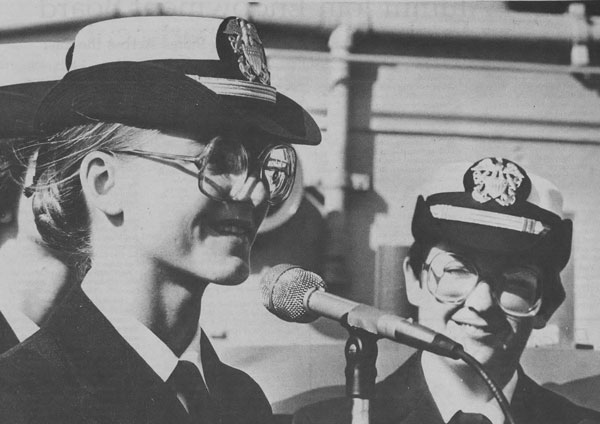Forty years ago, W&M women made waves
November 12, 2018
By
Sara K. Eskridge

In October 1775, the Continental Congress voted to arm two vessels with crew and weapons for the purpose of intercepting British transports heading to North America — so was born the U.S. Navy. It was not until 203 years later, in July 1978, that Judge John Sirica, still infamous from his pivotal role in the Watergate case, ruled that it was unconstitutional for Congress to bar women from serving on U.S. Navy ships. That November, a handful of women made history when they became the first female crew members of a non-hospital naval vessel.
Among those first eight women were two recent William & Mary grads, Mary Pat Carroll ’77 and Jo Anne Carlton ’77. Carlton says she has no idea why she and her fellow trailblazers were chosen for the honor.
“In Officer Candidate School, several of us were asked if we would be interested in serving aboard ship if the opportunity were available. It may have had to do with class standing, or they might have just gone down the roster and taken everyone who said yes,” she remembers. “Being a Trekkie, I was thrilled to be assigned to the Vulcan, but that probably didn’t have a bearing on my selection!”
Their jobs were not exotic — Carlton was an administrative and legal officer and Carroll was a communications officer. Yet, their arrival on board the repair ship U.S.S. Vulcan was greeted with a phalanx of photographers and reporters from all over the commonwealth, nation and world.
Women joining the regular fleet was not without controversy. In Owens v. Brown, four Navy women alleged that they had been disqualified from sea duty despite the fact that their jobs involved repairing and maintaining equipment primarily found aboard ships. When the court ruled their barring unconstitutional, there were many voices, both male and female, that claimed female sailors would lower readiness and morale. The wives of male sailors wondered aloud if these women would steal their husbands.
Because all of the women served in different departments, there was little in the way of daily interaction, although Carlton and Carroll roomed together and Carlton recalls that they often ate meals together. Nonetheless, Carroll and Carlton claimed at the time that their experience aboard the U.S.S. Vulcan had been, well, smooth sailing.
“The generally demanding pace of the ship precluded much socializing and most of the men were happy to see us because we were filling jobs that had been open for months, and they were glad to have someone doing the work,” Carlton recalls. “I had no trouble with any of the men I worked with — our captain was very supportive, which set the tone. They had clearly been told that the women were here to stay so there was no point in complaining.”
After her time on the USS Vulcan, Carlton ultimately spent her entire career in the Navy, retiring in 2004. It never was her intention to spend her life in military service, but she remains happy with her choice to this day.
“The Navy kept offering me assignments I couldn’t pass up, either because the job was interesting or because the location sounded good,” she says. “For the most part, I worked with good people, for good people, and traveled the world. Those perks made less-than-pleasant jobs better and good jobs great.”